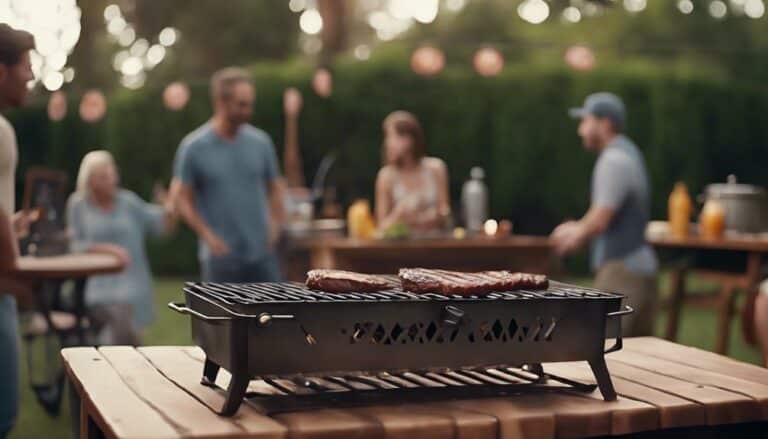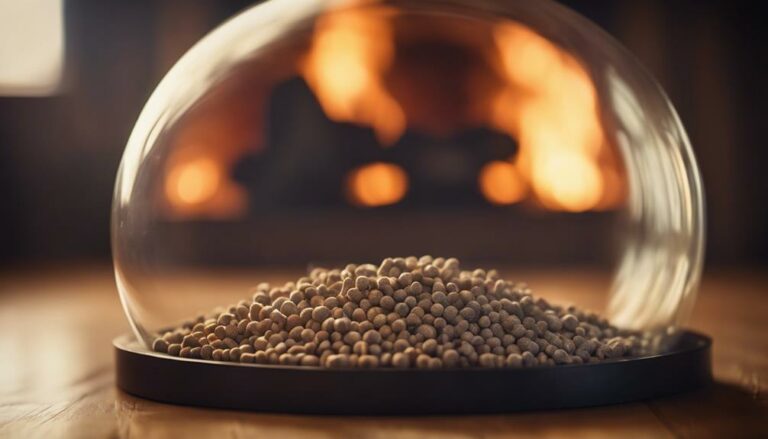As a grilling enthusiast, I know the importance of mastering the art of grilling. That sizzling sound, the mouthwatering aroma, and the juicy tenderness of perfectly cooked meat – it all starts with the right techniques.
In this article, I’ll share easy techniques for beginners to help you become a grilling master. From choosing the right grill to understanding temperature control and enhancing flavor, get ready to elevate your grilling game and impress your friends and family with delicious meals hot off the grill.
Let’s get started!
Table of Contents
Key Takeaways
- Gas grills are a convenient option for beginners due to their ease of use and temperature control.
- Proper cleaning and maintenance of the grill are important for taste and longevity.
- Understanding direct and indirect heat and mastering heat distribution techniques are essential for perfectly grilled meats.
- Temperature control is crucial for achieving consistent and safe grilling results, and using a grill thermometer is a valuable tool for precision.
Choosing the Right Grill for Beginners
I think the right grill for beginners is a gas grill because it’s easy to use and control the temperature.
When it comes to grilling, there are several types of grills to choose from, including gas, charcoal, and electric grills. While each type has its own advantages, a gas grill is the best option for beginners.
Gas grills are user-friendly, with features like electronic ignition and adjustable burners that make starting and controlling the grill a breeze. They also allow for precise temperature control, which is crucial for beginner-friendly grilling techniques.
With a gas grill, you can easily achieve the perfect sear on your steaks or the ideal char on your vegetables.

Essential Tools and Equipment for Grilling
When it comes to grilling, having the essential tools and equipment is crucial for a successful cookout. As someone who’s mastered the art of grilling, I can tell you that the right grilling utensils and grill accessories can make all the difference in your cooking experience.
Here are three must-have items that every grilling enthusiast should have in their arsenal:
- Grill Tongs: These are an absolute necessity for flipping and turning your food on the grill. Look for tongs with long handles and a sturdy grip to ensure you’ve full control over your food.
- Meat Thermometer: To achieve perfectly cooked meats every time, a reliable meat thermometer is essential. This tool allows you to monitor the internal temperature of your meat, ensuring it’s cooked to perfection and safe to eat.
- Grill Brush: Keeping your grill clean is essential for maintaining its performance and longevity. Invest in a good quality grill brush with sturdy bristles to easily remove any residue or debris from your grill grates.
With these essential grilling utensils and accessories, you’ll be well-equipped to tackle any grilling challenge and impress your guests with mouthwatering dishes.
Preparing Your Grill: Cleaning and Maintenance Tips
To ensure optimal performance and longevity of your grill, it’s important to regularly clean and maintain it. Proper grill maintenance not only enhances the taste of your food but also extends the lifespan of your equipment.
One of the most important grill cleaning techniques is to remove any leftover food particles and grease after each use. This can be done by brushing the grates with a wire brush while the grill is still hot.
Additionally, it’s essential to periodically clean the exterior of the grill, as well as the burners and the drip pan. This can be done using a mild soap and water solution, followed by a thorough rinse.
Lastly, don’t forget to check for any signs of wear and tear, such as rust or loose parts, and make the necessary repairs or replacements.
Understanding Direct and Indirect Heat: Grilling Zones Explained
Understanding direct and indirect heat is essential for mastering the art of grilling.
Direct heat is when food is placed directly over the flame or heat source, resulting in a quick sear and intense heat.
On the other hand, indirect heat involves placing the food away from the heat source, allowing for slower, more gentle cooking.
Heat Distribution Techniques
I find that using a two-zone heat distribution technique is essential for achieving perfectly grilled meats. By properly positioning the heat, you can control the cooking process and ensure that your food is cooked to perfection.
Here are three key elements to consider when using heat distribution techniques:
- Proper heat placement: When setting up your grill, create two zones – one with direct heat and one with indirect heat. This allows you to sear your meat over high heat and then move it to a cooler area to continue cooking without charring the outside.
- Temperature control: Use a thermometer to monitor the heat in each zone. This will help you maintain consistent temperatures and avoid overcooking or undercooking your food.
- Adjusting the heat: By moving your food between the direct and indirect heat zones, you can control the rate of cooking. This is particularly useful for thick cuts of meat that need to be seared quickly and then cooked through more slowly.
Mastering these heat distribution techniques will elevate your grilling game and ensure that your meats are perfectly cooked every time.
Grilling Temperature Control
Monitoring the temperature of the grill is crucial for achieving the desired level of doneness in my meats. Temperature monitoring allows me to have full control over the cooking process, ensuring that my meats are cooked to perfection every time.
One important factor in temperature control is heat retention. To retain heat effectively, I make sure to preheat the grill for at least 15 minutes before cooking. This allows the grates and the entire cooking surface to reach the desired temperature.
I also use a grill thermometer to accurately monitor the temperature throughout the grilling process. This ensures that I maintain a consistent heat level, resulting in evenly cooked meats.
Advantages of Each Method
One advantage of using a grill thermometer is that it provides accurate temperature readings throughout the cooking process. This is essential for achieving perfect results when grilling.
Here are three reasons why a grill thermometer is a valuable tool for mastering grilling techniques and enhancing flavor infusion:
- Precision: A grill thermometer allows you to monitor the exact temperature of your grill, ensuring that your food is cooked to perfection. This is particularly important for delicate cuts of meat or when using indirect heat methods.
- Consistency: By maintaining a consistent temperature, a grill thermometer helps you achieve consistent results every time you grill. This is crucial for developing your grilling skills and becoming a true master of the grill.
- Safety: With a grill thermometer, you can ensure that your food reaches the proper internal temperature to eliminate any harmful bacteria. This is especially important for poultry and ground meats to prevent foodborne illnesses.

Mastering the Art of Temperature Control
Mastering the art of temperature control is crucial for achieving perfect grilling results.
By understanding heat management tips and temperature adjustment techniques, you can have full control over your grill’s temperature.
Whether you’re searing a steak or slow-cooking ribs, knowing how to control the grill temperature will ensure that your food is cooked to perfection every time.
Heat Management Tips
I find it crucial to maintain a consistent temperature while grilling to ensure even cooking. Proper heat management techniques are essential for achieving the perfect grilled dishes. Here are three tips to help you control the grill temperature like a pro:
- Use a two-zone fire: Create a hot zone and a cool zone on your grill by placing coals or burners on one side and leaving the other side empty. This allows you to sear food over direct heat and then move it to the cooler side for slower, indirect cooking.
- Adjust the vents: Most grills have vents that control the airflow, affecting the temperature. To increase the heat, open the vents to allow more oxygen in. To lower the temperature, close the vents partially to restrict airflow.
- Monitor with a thermometer: Use a reliable grill thermometer to keep track of the temperature. This will help you make precise adjustments and ensure consistent cooking results.
Temperature Adjustment Techniques
When it comes to grilling, temperature control is key. To achieve the perfect cook, you must be able to adjust the temperature of your grill. This is where temperature monitoring and adjusting grill vents come into play.
Monitoring the temperature of your grill is crucial for achieving consistent results. A reliable meat thermometer can help you track the internal temperature of your food, ensuring it is cooked to perfection. Additionally, some grills come with built-in temperature gauges that allow you to keep an eye on the heat.
Adjusting grill vents is another effective technique for temperature control. By opening or closing the vents, you can regulate the airflow and therefore the temperature inside the grill. Opening the vents allows more oxygen in, increasing the heat, while closing them restricts airflow, lowering the temperature.
To further emphasize the importance of temperature monitoring and adjusting grill vents, here is a table:
| Temperature Adjustment Technique | Benefits |
|---|---|
| Temperature Monitoring | Ensures consistent results |
| Adjusting Grill Vents | Regulates airflow and temperature |
Controlling Grill Temperature
Controlling the grill temperature is essential for achieving the desired level of doneness in my food. Temperature regulation and heat control are key factors in grilling success. Here are three important techniques to help master this skill:
- Preheating the grill: Before cooking, preheat the grill with the lid closed. This ensures that the cooking surface reaches the desired temperature evenly.
- Zone cooking: Create different heat zones on the grill by placing the coals or burners on one side, leaving the other side cooler. This allows for both direct and indirect cooking, giving me more control over the level of doneness.
- Adjusting the vents: Most grills have vents at the top and bottom. By adjusting these vents, I can control the airflow, which in turn controls the level of heat. Opening the vents allows more oxygen in, increasing the heat, while closing them reduces the airflow, lowering the temperature.

Marinating and Seasoning: Enhancing Flavor on the Grill
Adding a marinade or seasoning to your meat before grilling can greatly enhance its flavor. Marinades are a fantastic way to infuse your meat with delicious flavors and tenderize it at the same time.
There are a few key techniques to keep in mind when marinating your meat. Firstly, make sure to choose the right marinade for the type of meat you’re grilling. For example, acidic marinades work well with tougher cuts of meat, while sweeter marinades are great for chicken or seafood.
Secondly, ensure that you marinate your meat for the appropriate amount of time. This can range from a few hours to overnight, depending on the intensity of flavor you desire.
Lastly, don’t forget to pat your meat dry before grilling to ensure a nice sear and avoid excess moisture.
Grilling Safety: Tips for a Successful and Safe Grilling Experience
Now that we’ve covered the importance of marinating and seasoning your food for a flavorful grilling experience, let’s shift our focus to grilling safety.
Ensuring a successful and safe grilling experience requires careful attention to grill maintenance and fire safety.
To maintain your grill, regularly clean the grates and remove any grease buildup. This not only helps prevent flare-ups but also extends the lifespan of your grill. Additionally, inspect the gas or charcoal connections before each use to ensure there are no leaks or loose fittings.
When it comes to fire safety, here are three key tips to keep in mind:
- Keep a fire extinguisher nearby: Accidents can happen, so it’s crucial to have a fire extinguisher within reach in case of emergencies.
- Create a safe grilling zone: Set up your grill in an open area away from any flammable objects, such as trees or buildings. This helps minimize the risk of accidental fires.
- Never leave your grill unattended: Grilling requires constant supervision. Always stay near the grill and avoid leaving it unattended, especially when children or pets are present.
Frequently Asked Questions
Can I Use a Gas Grill for Indirect Grilling?
Yes, you can use a gas grill for indirect grilling. It offers convenience and control over temperature. Indirect grilling allows for slow cooking and is great for larger cuts of meat.
How Long Do I Need to Preheat My Grill Before Cooking?
How long do I need to preheat my grill before cooking? Well, it depends on the type of grill and the desired grilling temperature. Generally, it takes about 15-20 minutes to reach the optimal cooking temperature.
What Is the Best Way to Clean Grill Grates?
To clean grill grates effectively and remove stubborn grime, I recommend a thorough maintenance routine. Start by preheating the grill, then scrub the grates with a wire brush and use a mixture of water and vinegar for a deep clean.
Can I Use Regular Table Salt for Seasoning Meat Before Grilling?
Yes, you can use regular table salt for seasoning meat before grilling, but using kosher salt is recommended. Kosher salt has larger flakes that adhere better to the meat, enhancing flavor and creating a delicious crust.
How Do I Know When My Meat Is Cooked to the Desired Temperature?
Knowing when my meat is cooked to the desired temperature is crucial. While a meat thermometer is the most accurate method, I can also use alternative methods like touch test or visual cues.
Conclusion
In conclusion, grilling can be a fun and rewarding experience for beginners with the right knowledge and techniques.
By choosing the right grill, using essential tools and equipment, and understanding heat zones and temperature control, you can easily create delicious and flavorful dishes.
Remember to prioritize safety and enjoy the process of experimenting with different marinades and seasonings.
With these easy techniques, you’ll be grilling like a pro in no time!










